Peer-Olaf Siebers
Exploring the Potential of Conversational AI Support for Agent-Based Social Simulation Model Design
May 12, 2024Abstract:ChatGPT, the AI-powered chatbot with a massive user base of hundreds of millions, has become a global phenomenon. However, the use of Conversational AI Systems (CAISs) like ChatGPT for research in the field of Social Simulation is still limited. Specifically, there is no evidence of its usage in Agent-Based Social Simulation (ABSS) model design. While scepticism towards anything new is inherent to human nature, we firmly believe it is imperative to initiate the use of this innovative technology to support ABSS model design. This paper presents a proof-of-concept that demonstrates how CAISs can facilitate the development of innovative conceptual ABSS models in a concise timeframe and with minimal required upfront case-based knowledge. By employing advanced prompt engineering techniques and adhering to the Engineering ABSS framework, we have constructed a comprehensive prompt script that enables the design of ABSS models with or by the CAIS. The effectiveness of the script is demonstrated through an illustrative case study concerning the use of adaptive architecture in museums. Despite occasional inaccuracies and divergences in conversation, the CAIS proved to be a valuable companion for ABSS modellers.
Using simulation to incorporate dynamic criteria into multiple criteria decision-making
Nov 16, 2020Abstract:In this paper, we present a case study demonstrating how dynamic and uncertain criteria can be incorporated into a multicriteria analysis with the help of discrete event simulation. The simulation guided multicriteria analysis can include both monetary and non-monetary criteria that are static or dynamic, whereas standard multi criteria analysis only deals with static criteria and cost benefit analysis only deals with static monetary criteria. The dynamic and uncertain criteria are incorporated by using simulation to explore how the decision options perform. The results of the simulation are then fed into the multicriteria analysis. By enabling the incorporation of dynamic and uncertain criteria, the dynamic multiple criteria analysis was able to take a unique perspective of the problem. The highest ranked option returned by the dynamic multicriteria analysis differed from the other decision aid techniques.
Simulating user learning in authoritative technology adoption: An agent based model for council-led smart meter deployment planning in the UK
Jul 20, 2016



Abstract:How do technology users effectively transit from having zero knowledge about a technology to making the best use of it after an authoritative technology adoption? This post-adoption user learning has received little research attention in technology management literature. In this paper we investigate user learning in authoritative technology adoption by developing an agent-based model using the case of council-led smart meter deployment in the UK City of Leeds. Energy consumers gain experience of using smart meters based on the learning curve in behavioural learning. With the agent-based model we carry out experiments to validate the model and test different energy interventions that local authorities can use to facilitate energy consumers' learning and maintain their continuous use of the technology. Our results show that the easier energy consumers become experienced, the more energy-efficient they are and the more energy saving they can achieve; encouraging energy consumers' contacts via various informational means can facilitate their learning; and developing and maintaining their positive attitude toward smart metering can enable them to use the technology continuously. Contributions and energy policy/intervention implications are discussed in this paper.
Juxtaposition of System Dynamics and Agent-based Simulation for a Case Study in Immunosenescence
Jul 20, 2016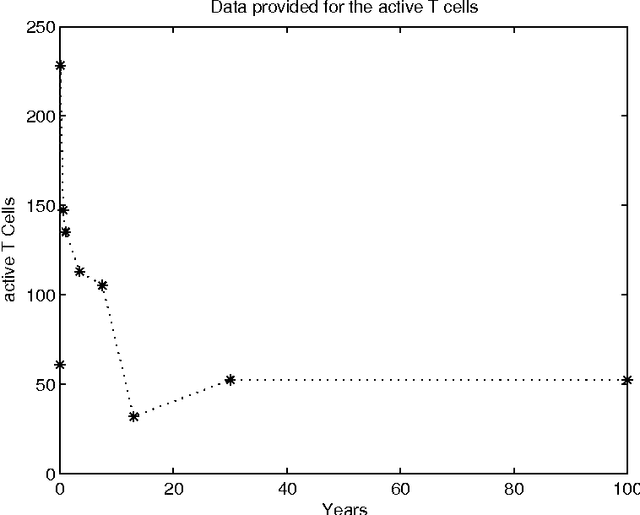
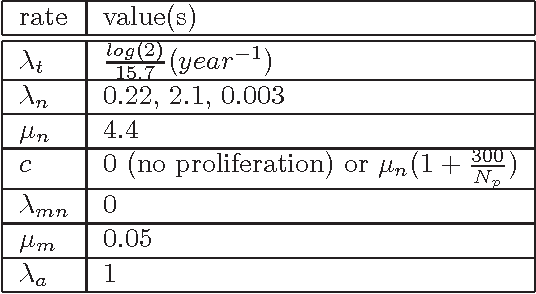
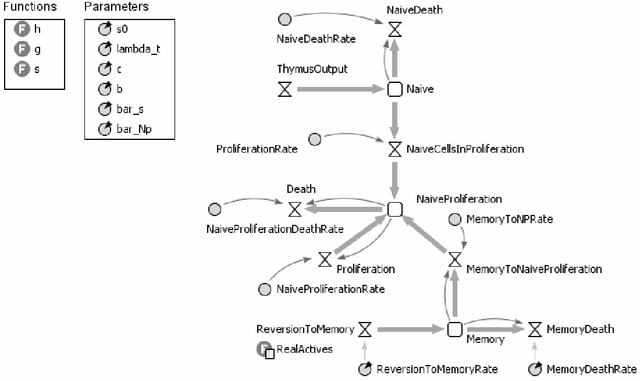
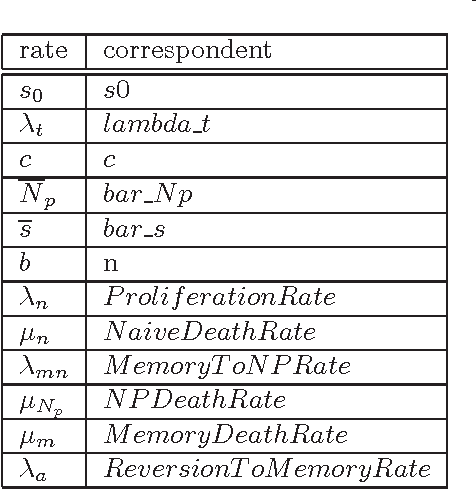
Abstract:Advances in healthcare and in the quality of life significantly increase human life expectancy. With the ageing of populations, new un-faced challenges are brought to science. The human body is naturally selected to be well-functioning until the age of reproduction to keep the species alive. However, as the lifespan extends, unseen problems due to the body deterioration emerge. There are several age-related diseases with no appropriate treatment; therefore, the complex ageing phenomena needs further understanding. Immunosenescence, the ageing of the immune system, is highly correlated to the negative effects of ageing, such as the increase of auto-inflammatory diseases and decrease in responsiveness to new diseases. Besides clinical and mathematical tools, we believe there is opportunity to further exploit simulation tools to understand immunosenescence. Compared to real-world experimentation, benefits include time and cost effectiveness due to the laborious, resource-intensiveness of the biological environment and the possibility of conducting experiments without ethic restrictions. Contrasted with mathematical models, simulation modelling is more suitable for representing complex systems and emergence. In addition, there is the belief that simulation models are easier to communicate in interdisciplinary contexts. Our work investigates the usefulness of simulations to understand immunosenescence by employing two different simulation methods, agent-based and system dynamics simulation, to a case study of immune cells depletion with age.
Modelling Office Energy Consumption: An Agent Based Approach
Jul 20, 2016



Abstract:In this paper, we develop an agent-based model which integrates four important elements, i.e. organisational energy management policies/regulations, energy management technologies, electric appliances and equipment, and human behaviour, based on a case study, to simulate the energy consumption in office buildings. With the model, we test the effectiveness of different energy management strategies, and solve practical office energy consumption problems. This paper theoretically contributes to an integration of four elements involved in the complex organisational issue of office energy consumption, and practically contributes to an application of agent-based approach for office building energy consumption study.
Investigating Mathematical Models of Immuno-Interactions with Early-Stage Cancer under an Agent-Based Modelling Perspective
May 31, 2013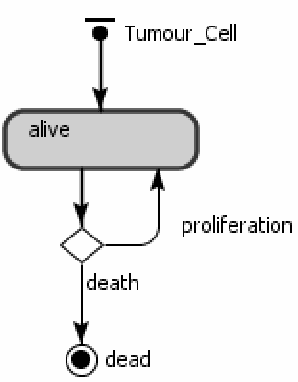
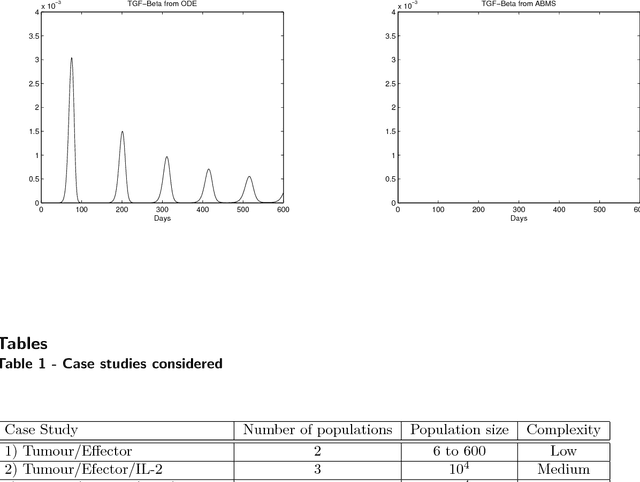


Abstract:Many advances in research regarding immuno-interactions with cancer were developed with the help of ordinary differential equation (ODE) models. These models, however, are not effectively capable of representing problems involving individual localisation, memory and emerging properties, which are common characteristics of cells and molecules of the immune system. Agent-based modelling and simulation is an alternative paradigm to ODE models that overcomes these limitations. In this paper we investigate the potential contribution of agent-based modelling and simulation when compared to ODE modelling and simulation. We seek answers to the following questions: Is it possible to obtain an equivalent agent-based model from the ODE formulation? Do the outcomes differ? Are there any benefits of using one method compared to the other? To answer these questions, we have considered three case studies using established mathematical models of immune interactions with early-stage cancer. These case studies were re-conceptualised under an agent-based perspective and the simulation results were then compared with those from the ODE models. Our results show that it is possible to obtain equivalent agent-based models (i.e. implementing the same mechanisms); the simulation output of both types of models however might differ depending on the attributes of the system to be modelled. In some cases, additional insight from using agent-based modelling was obtained. Overall, we can confirm that agent-based modelling is a useful addition to the tool set of immunologists, as it has extra features that allow for simulations with characteristics that are closer to the biological phenomena.
Modelling Electricity Consumption in Office Buildings: An Agent Based Approach
May 31, 2013



Abstract:In this paper, we develop an agent-based model which integrates four important elements, i.e. organisational energy management policies/regulations, energy management technologies, electric appliances and equipment, and human behaviour, to simulate the electricity consumption in office buildings. Based on a case study, we use this model to test the effectiveness of different electricity management strategies, and solve practical office electricity consumption problems. This paper theoretically contributes to an integration of the four elements involved in the complex organisational issue of office electricity consumption, and practically contributes to an application of an agent-based approach for office building electricity consumption study.
Modelling and Analysing Cargo Screening Processes: A Project Outline
May 30, 2013Abstract:The efficiency of current cargo screening processes at sea and air ports is unknown as no benchmarks exists against which they could be measured. Some manufacturer benchmarks exist for individual sensors but we have not found any benchmarks that take a holistic view of the screening procedures assessing a combination of sensors and also taking operator variability into account. Just adding up resources and manpower used is not an effective way for assessing systems where human decision-making and operator compliance to rules play a vital role. For such systems more advanced assessment methods need to be used, taking into account that the cargo screening process is of a dynamic and stochastic nature. Our project aim is to develop a decision support tool (cargo-screening system simulator) that will map the right technology and manpower to the right commodity-threat combination in order to maximize detection rates. In this paper we present a project outline and highlight the research challenges we have identified so far. In addition we introduce our first case study, where we investigate the cargo screening process at the ferry port in Calais.
A First Approach on Modelling Staff Proactiveness in Retail Simulation Models
Aug 15, 2011



Abstract:There has been a noticeable shift in the relative composition of the industry in the developed countries in recent years; manufacturing is decreasing while the service sector is becoming more important. However, currently most simulation models for investigating service systems are still built in the same way as manufacturing simulation models, using a process-oriented world view, i.e. they model the flow of passive entities through a system. These kinds of models allow studying aspects of operational management but are not well suited for studying the dynamics that appear in service systems due to human behaviour. For these kinds of studies we require tools that allow modelling the system and entities using an object-oriented world view, where intelligent objects serve as abstract "actors" that are goal directed and can behave proactively. In our work we combine process-oriented discrete event simulation modelling and object-oriented agent based simulation modelling to investigate the impact of people management practices on retail productivity. In this paper, we reveal in a series of experiments what impact considering proactivity can have on the output accuracy of simulation models of human centric systems. The model and data we use for this investigation are based on a case study in a UK department store. We show that considering proactivity positively influences the validity of these kinds of models and therefore allows analysts to make better recommendations regarding strategies to apply people management practises.
* 25 pages, 3 figures, 10 tables
Towards the Development of a Simulator for Investigating the Impact of People Management Practices on Retail Performance
Jun 21, 2010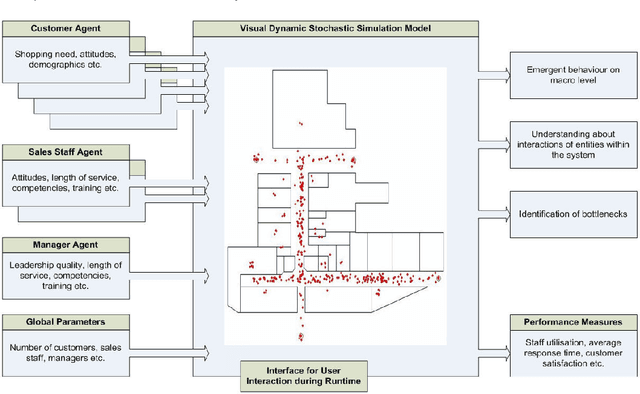

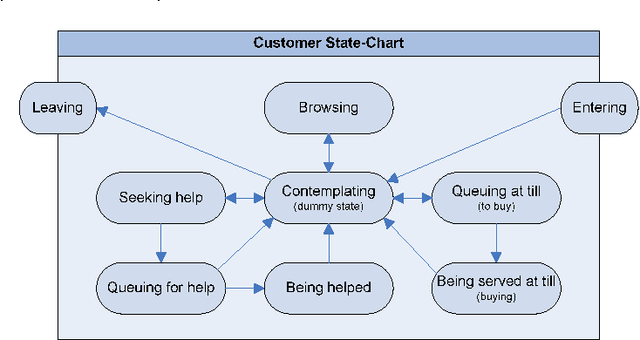

Abstract:Often models for understanding the impact of management practices on retail performance are developed under the assumption of stability, equilibrium and linearity, whereas retail operations are considered in reality to be dynamic, non-linear and complex. Alternatively, discrete event and agent-based modelling are approaches that allow the development of simulation models of heterogeneous non-equilibrium systems for testing out different scenarios. When developing simulation models one has to abstract and simplify from the real world, which means that one has to try and capture the 'essence' of the system required for developing a representation of the mechanisms that drive the progression in the real system. Simulation models can be developed at different levels of abstraction. To know the appropriate level of abstraction for a specific application is often more of an art than a science. We have developed a retail branch simulation model to investigate which level of model accuracy is required for such a model to obtain meaningful results for practitioners.
 Add to Chrome
Add to Chrome Add to Firefox
Add to Firefox Add to Edge
Add to Edge